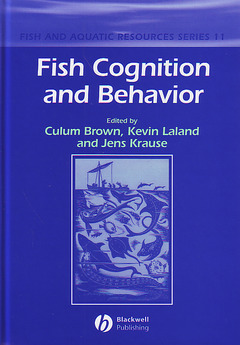Fish cognition and behavior
Auteurs : BROWN, BAER, PINES

1. Fish cognition and behaviour (Culum Brown, Kevin Laland & Jens Krause).
1.2 Introduction.
1.3 Acknowledgements.
1.4 References.
2. Learning of foraging skills by fish (Kevin Warburton).
2.1 Introduction.
2.2 Some factors affecting the learning process.
2.2.1 Reinforcement.
2.2.1 Drive.
2.2.3 Stimulus attractiveness.
2.2.4 Exploration and sampling.
2.2.5 Attention and simple association.
2.2.6 Cognition.
2.3 Patch use and probability matching.
2.4 Performance.
2.5 Tracking environmental variation.
2.6 Competition.
2.7 Learning and fish feeding: Some applications.
2.8 Conclusions.
2.9 Acknowledgments.
2.10 References.
3. Learned defences and counter defences in predator prey interactions (Anne Magurran & Jennifer Kelly).
3.1 Introduction.
3.2 The predator prey sequence.
3.2.1 Avoidance.
3.2.1.1 Avoiding dangerous habitats.
3.2.1.2 Changing activity patterns.
3.2.2 Detection.
3.2.2.1 Crypsis.
3.2.2.2 Sensory perception.
3.2.3 Recognition.
3.2.3.1 Associative learning.
3.2.3.2 Learning specificity.
3.2.3.3 Search images.
3.2.3.4 Aposematism and mimicry.
3.2.4 Approach.
3.2.4.1 Pursuit deterrence.
3.2.4.2 Gaining information about the predator.
3.2.4.3 Social learning.
3.2.4.4 Habituation.
3.2.5 Evasion.
3.2.5.1 Reactive distance and escape speed.
3.2.5.2 Survival benefits.
3.3 Summary and discussion.
3.4 Acknowledgements.
3.5 References.
4. Learning about Danger: chemical alarm cues and the assessment of predation risk by fishes (Grant Brown & Douglas P Chivers).
4.1 Introduction.
4.2 Chemical alarm cues and flexible responses.
4.3 Temporal variability and the intensity of antipredator behaviour.
4.4 Predator diet cues and risk assessment during predator inspection.
4.5 Acquired predator recognition.
4.6 Constraints on learning.
4.7 Heterospecific responses.
4.8 Concluding Remarks.
4.9 Acknowledgements.
4.10 References.
5. Learning & Mate Choice (Klaudia Witte).
5.1 Introduction.
5.2 Sexual imprinting.
5.2.1 Sexual imprinting in fishes.
5.2.2 Does sexual imprinting promote sympatric speciation in fish?
5.3 Learning after reaching maturity.
5.3.1 Learning when living in sympatry or allopatry.
5.3.2 Learned recognition of colour morphs in mate choice.
5.4 Eavesdropping.
5.4.1 Eavesdropping and mate choice.
5.4.2 The audience effect.
5.4.3 Benefits of eavesdropping.
5.5 Mate choice copying.
5.5.1 Mate choice copying first experimental evidence and consequence.
5.5.2 Mate choice copying Evidence from the wild.
5.5.3 Copying mate rejection.
5.5.4 The disruption hypothesis an alternative explanation to mate choice copying?.
5.6 Social mate preferences overriding genetic preferences.
5.6.1 Indication from guppies.
5.6.2 Indications from sailfin mollies.
5.7 Cultural evolution through mate choice copying.
5.8 Does mate choice copying support the evolution of a novel male trait?.
5.8.1 Female preference for swords.
5.8.2 Theoretical approaches.
5.8.3 Experimental...
Date de parution : 10-2006
Ouvrage de 352 p.
24.4x17.2 cm



